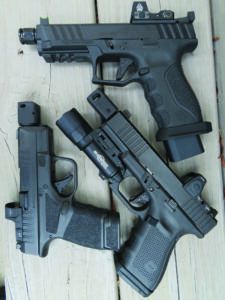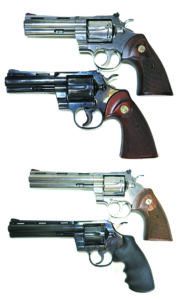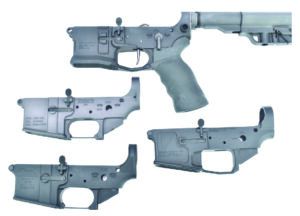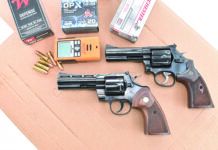Re “Testing the 30 Super Carry Vs. 380 ACP and 9mm Pistols,” July 2022
Hi Todd, I read your review of the various versions of the Smith & Wesson EZ series of firearms with great interest. I have an EZ in 380 ACP and love the gun, with one exception. The mags nominally hold eight rounds, but I have found loading the last round to be difficult, even with a loader. What’s more, with eight cartridges in the mag, the mag is very hard to seat unless the slide is locked back. When the mag is seated with the slide in battery, my weak old hands cannot rack the slide. Is this a unique feature of my weapon, or did your testers find the same problem? Love the magazine, keep up the good work. — Bob
Hey Bob: No, we didn’t have that problem with any of our test guns. It sounds like the feed lips get pushed out when a full stack of rounds is pushing up from the bottom of the mag. With one fewer round in the stack, the upward pressure isn’t as forceful, so you don’t have as much interference. You might try polishing the top of a magazine with a Dremel tool (no grit, just a polish wheel), fully load it, and try to work the action. Rinse and repeat. It would only take a minimal metal drag to cause the trouble you describe. Also, are all the magazines affected the same way? If one works better than the others, then that’s another signal the mechanical problem is magazine related. — Todd Woodard
I read with interest the 380 ACP, 30 Super Carry, and the 9mm comparison test in the July 2022 issue. The results were as one would expect. The 380 ACP was the weakest performer. The 9mm was the strongest performer. And the 30 Super Carry was close but slightly inferior to the 9mm. No blinding flash of insight there. But is the comparison valid?
The test guns were all 9mm-sized pistols. The 380 ACP can be carried in a much lighter, smaller, and more compact pistol than that. The 380 ACP is a genuine pocket pistol in guns like the Ruger LCP. The other two are too large to fit in a pocket. They require some form of external or inside-the-waistband holster. That makes them more cumbersome and bulky and more difficult to conceal. This significant size differential is a major advantage for the 380 ACP. It is not getting enough attention in these comparisons.
The 380 ACP and its pistols are in a different category than the 9mm or 30 Super Carry. It is less powerful, yet more compact and concealable. This size advantage is a significant reason why the 380 ACP is a very popular concealed-carry caliber. The addition of the 30 Super Carry does nothing to change this inherent strength. The inclusion of the 380 ACP with the other two obviously larger and more powerful calibers is a case of comparing apples to oranges.
Remember, the best gun to have in a gun fight is the one you have with you. The inherent concealability advantage of the 380 ACP should be given more credit. Its smaller size makes the 380 ACP more likely to be there when you need it. — John
Hey John, thanks for reading. The three EZ pistols tested gave each chambering a fair shake, the fairest possible, as the guns weigh pretty much the same. The comparison was much more an assessment of the 30 Super Carry as a new chambering for self-defense pistols, so we fired them in very similar, almost identical, handguns. These EZ handguns and the 30 Super are not marketed as pocket pistols; instead, they are marketed as pistols that are easy to rack and shoot for folks who want less recoil. The raters, folks of considerable experience both as police and military personnel, wouldn’t carry the 380 ACP for personal use, despite claims to the contrary in other media. That’s why we were transparent in describing that bias, so readers could assess that opinion in regards to their own personal use. We agree that any gun is better than no gun. But, in guns of the same form factor, the 30 Super is superior to the 380 ACP, or as you say, “No blinding flash of insight there.” But our readers expect us to make that assessment at the range, head to head, and report the results, even if the outcome seems obvious. Then, also, in the EZ pistols as chambered, if the 9mm bothers you, the 30 Super is a good choice. That’s our conclusion. — Bob Campbell
Re “Roland Special 9mm Builds from Glock, Springfield, and Stoeger,” June 2022
 In this issue, you made three “Roland Specials.” On the Glock, as far as I can tell, you replaced the barrel, sights, trigger, slide, and internals. Of the OEM parts, it seems that all you used was the handle. You took a serviceable $700 pistol and made it a $2200 Frankengun. I have to ask the question: Why not just buy the parts you actually used instead of a whole pistol and save money? Admittedly, I am not a fan of “builds.” My feeling is, if you are thinking of buying a gun, and it needs a major overhaul to become what you want, buy another gun that is what you want. Saves money and time. Tell me why I am wrong. — Carl
In this issue, you made three “Roland Specials.” On the Glock, as far as I can tell, you replaced the barrel, sights, trigger, slide, and internals. Of the OEM parts, it seems that all you used was the handle. You took a serviceable $700 pistol and made it a $2200 Frankengun. I have to ask the question: Why not just buy the parts you actually used instead of a whole pistol and save money? Admittedly, I am not a fan of “builds.” My feeling is, if you are thinking of buying a gun, and it needs a major overhaul to become what you want, buy another gun that is what you want. Saves money and time. Tell me why I am wrong. — Carl
Hey Carl, Thanks for the email. I admit the frugal Yankee in me had second thoughts once I tallied the total cost, but a Roland Special build isn’t about getting a good gun at a good price, which is what we usually do in Gun Tests. Roland Special builds allow you to construct a pistol that reflects your needs, desires, and personality. Attempting a build is not for everyone — and you admit you are not fan — and while it might seem odd to tear apart a perfectly good gun to build another, that’s what tinkerers and amateur gunsmiths do. Sure, I could have saved a few bucks by purchasing a strip frame, but I had a Gen4 G19 on hand. I’m not going to tell you that you are wrong, but I’m not going say you are right either. I had a lot of fun putting together that Glock Roland, and it would have been difficult to find one that was exactly what I wanted. — Robert Sadowski
Re “Colt Reboots The Classic Snake: We Test Four Pythons,” January 2021
Todd, as a long-time reader, I want to heartily congratulate you, Gun Tests, and Robert Sadowski for this outstanding article.
To date, I’m fortunate enough to own both the 4.25- and the 6-inch 2020 Colt Python revolvers. As well, I’d been fortunate to formerly own a variety of six original model Pythons ranging from a 4-inch blued 1968 model, a 1992 6-inch Ultimate Stainless model (the Rick Grimes gun!), a 1974 4-inch nickel-plated model, a 4-inch 1990s vintage Ultimate Stainless model, a 4-inch 1980s vintage blued model, and a 2003 vintage 4-inch stainless Python Elite. Yes, I was goofy to let those guns go, I’ll freely admit it; I’m sure I have legions of gun-owning brethren who have similar lengthy “regret lists.”

Anyway, with all that bit of Python experience, I agree with virtually everything Mr. Sadowski said in his article, except for one somewhat minor point. He says: “Modern manufacturing methods like metal injection molding, or MIM, allow Colt to greatly reduce the cost to produce small components like the hammer and trigger.” Whereas, in Keith Wood’s article in Guns & Ammo’s April 2020 issue, “Colt Python — Does the new snake gun live up to the legend?”, Mr. Wood states: “Both the trigger and hammer are machined from billet stainless steel rather than injection molded from powdered metal.” Yes, I’m also keenly aware of many readers’ opinion of G&A being a paid-advertising rag, in contrast to Gun Tests’ stance of no paid advertising. But in all fairness, I don’t sense they are total sell-outs and are, to a good degree, somewhat fair and accurate quite often. But not always.
Now, I’m no insider expert or anything, and I’m certainly not calling “BS” on Gun Tests or Robert Sadowski, but I’m somewhat inclined to side with Mr. Wood’s assessment of those components. I could be dead-wrong, but the 2020 Python’s triggers and hammers look to me like machined billet parts. I say this particularly in comparison to a couple of 2017-model Colt Cobras I own, which I know have MIM’ed parts, in particular, the triggers, which bear the mark of the infamous “Ugly Crop Circle” as so many detractors of Colt’s MIM parts have named it. That is a roughly 1.5mm circle mark on the left side of the trigger, which in my view is a dead-giveaway for a MIM’ed part. Correct me if I’m wrong, please. Perhaps you could shed some more light into that corner? I’d openly welcome whatever findings you could share on this point with full credulity, out of respect for your esteemed publication’s reputation. I’ve been a Gun Tests Lifetime Subscriber for 19 years now, and an annual subscriber for years before that, and I regard your reports as my bottom-line reliable go-to source for straight-up gun quality information. Period.
Thanks again for the excellent article on America’s iconic darling of 357 Magnum revolvers, the Python. And I gotta say I totally agree with you and your staff that the 2020 Python has a bit of a leg-up on its ancestors and I’m quite thrilled with them — even if it does turn out they have a couple MIM parts. — Timothy
Hey Timothy: I heard back from my Colt contact, and he said the Python hammer and trigger are billet machined. Great catch. — Robert Sadowski
“Billet” vs. “Bar Stock”
 Writers sometimes resort to using euphemisms in order to catch readers’ attentions. A good example is the use of “billet” instead of “bar stock.” For gun writers that is erroneous. When metal alloys are created, the molten metal is poured into an ingot mold to solidify and cool. The ingot is then broken down into “billets,” which are further broken down into saleable products (e.g. sheet, plate, bar stock, pipe, forgings). Ordinarily, “billets” never leave the mill, or are available for sale from metal suppliers. Firearms manufacturers are never able to buy “billets”; however, they can and do buy “bar stock.” The erroneous use of the word “billet” is found in a number of places in the article, “Four AR-15 Lower Receivers Assembled and Range Tested,” which begins on page 17 in the April 2022 edition of Gun Tests. Respectfully submitted. — Irving
Writers sometimes resort to using euphemisms in order to catch readers’ attentions. A good example is the use of “billet” instead of “bar stock.” For gun writers that is erroneous. When metal alloys are created, the molten metal is poured into an ingot mold to solidify and cool. The ingot is then broken down into “billets,” which are further broken down into saleable products (e.g. sheet, plate, bar stock, pipe, forgings). Ordinarily, “billets” never leave the mill, or are available for sale from metal suppliers. Firearms manufacturers are never able to buy “billets”; however, they can and do buy “bar stock.” The erroneous use of the word “billet” is found in a number of places in the article, “Four AR-15 Lower Receivers Assembled and Range Tested,” which begins on page 17 in the April 2022 edition of Gun Tests. Respectfully submitted. — Irving
Irving: I reported what the manufacturer descriptions were for those lower receivers. But I appreciate the advice on using the most accurate terminology for the metal source. — Joe Woolley
Re “Springfield Armory Rifles Old and New: Which to Collect?” December 2021
I have subscribed to Gun Tests for years, and I have always enjoyed every issue. I have all three of those fine rifles. My Krag is all original, and my M-1A is a standard-grade piece. I tailor my ammo for each. They are outstanding!
I noted the comment about difficult in maintaining scope alignment on the M-1A. I found a solution to that problem. It is an M-14 scope mount made by Smith Enterprise, 1701 W. 10th Street, Suite 14, Tempe, AZ 85281, telephone (480) 964-1818 or email: SmithEnt@PhxCoxMail.com. Or this mount can be found at Brownells, (800) 741-0015 or Brownells.com. — John
Thank you John, for the field evaluation. The scope mount lists for $341 at Brownells.com (851-000-001WB). — tw




























